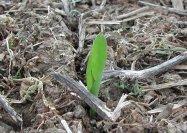Polymer-Coated Seed Corn
Dr. Chad Lee
859.257.3203
cdlee2@uky.edu
The goal of this study is to test a polymer seed coating known as “Intellicoat” seed technology. The polymer seed is designed to delay emergence until temperatures are ideal for germination and growth. This delay in emergence would allow farmers to plant corn earlier than normal.
Corn planting near Lexington should normally occur between April 15 and May 15. To test the polymer coating effect on corn germination, the seeds were planted on March 17, April 3 and May 13, 2003 at Lexington, Kentucky.
Two corn hybrids were planted with and without the seed coating. Air temperatures were warm enough for germination following each planting date. However, air temperatures near freezing occurred on March 23, March 31, April 12, April 13, April 14 and April 23. Frost occurred on April 23 and damaged the corn planted at the first two dates. These plants received additional damage from slugs.
More results of will be summarized as the study progresses.
Several counties are also experimenting with the polymer coated corn. Their updates will be included as well.
Report from Hardin County
As of April 21st... 75% of the non-treated early planted corn had emerged and only 30% of the treated. Bob planted the plots on April 1st. The seeds that had not emerged appeared to be still viable. I'm surprised at how uneven both treated and non-treated seed have been for emergence.
I'm disappointed with both Intellicoat treated and non-treated plots. Stand and emergence were highly variable for both ie. at 28,000 plants per acre seeding rate we have only a 68% stand for the treated plots and a 77% stand in the non-coated plots.
An interesting observation: The Intellicoat early plant corn emergence occurred over a 25-day period from first emergence to last. Consequently, the coated seed plot is much more uneven in plant height than the non-coated plot. Not something we should be striving for! Perhaps the cool, wet spring had an influence?
Report from Hopkins County
I'm not seeing any treatment difference to date. Perhaps we'll see something at harvest.
Report from Hopkins County
This corn was planted on April 4 and a very poor stand was observed on June 5, 2003. Frost had killed areas of the corn and some of the corn appeared to be at different stages of growth. Corn planted at early May was uniform and avoided any frost damage.

The corn on the left and center was planted on April 4, while the corn on the far right right was planted around the end of April. The corn planted April 4 received a heavy frost in late April that caused very poor stands after the frost. The corn planted in late April avoided the frost and has a very good stand. The corn on the left was at V5 growth stage and the corn on the right was at V4 on June 5, 2003.

Comparison of coated seedlings from coated corn (on the left) and uncoated corn (on the right). This photo was taken on April 28, 2003 in Ballard County.
(Picture was taken by Tom Miller, Ballard County Extension Agent for Agriculture and Natural Resources).

Polymer coated corn kernels are on the left, and uncoated kernels are on the right. You can see that the polymer coating has delayed emergence. These kernels were planted on April 14 and this photo was taken on April 22 in Ballard County, Kentucky. Temperatures were in the highs of 65 to 75O F most days. Average soil temperatures was near 61OF on April 22.
(Picture was taken by Tom Miller, Ballard County Extension Agent for Agriculture and Natural Resources).

Emerged corn damaged by the cold temperatures that dropped to or near freezing on April 5th and 6th in Lexington, Kentucky.

Corn emerging near Lexington, Kentucky in early April.

Planting the polymer-coated corn in Lexington, Kentucky on March 17, 2003.

Planting the polymer-coated corn in Shelby County, Kentucky on April 4, 2003.
